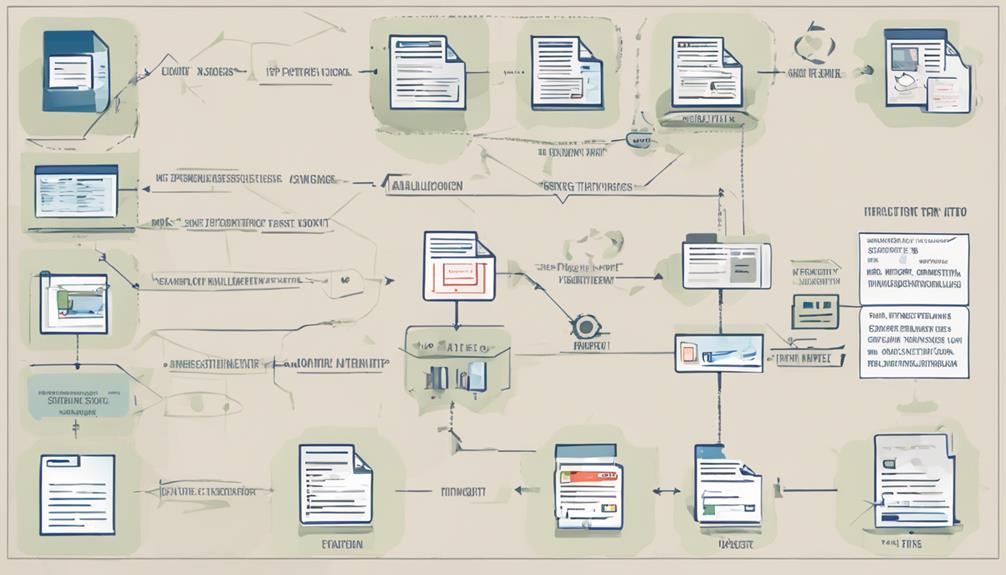If you’re navigating the realm of SGML conversion, having a reliable set of tools for SGML conversion is fundamental. But how do you ensure a seamless transition from SGML to XML formats? Unveil the key elements that will equip you with the efficiency and precision needed for this intricate process. From batch processing capabilities to meticulous manual conversion and error verification methods, each tool plays a pivotal role in the successful transformation of your SGML documents. Let’s explore the essential toolkit that will elevate your SGML conversion endeavors.
SGML Conversion Software
When it comes to SGML conversion, having the right software is essential. SGML Conversion Software plays a crucial role in efficiently converting large volumes of data into the structured SGML format. One of the key features to look for in SGML Conversion Software is batch processing capability. This allows you to convert multiple files simultaneously, saving time and streamlining the conversion process.
Additionally, effective SGML Conversion Software should excel in data extraction. This means the software can accurately extract data from various file formats and convert it into SGML markup language. The ability to handle complex data structures and accurately interpret content is essential for a smooth conversion process.
Manual SGML Conversion
For manual SGML conversion, a hands-on approach is required to meticulously convert data into SGML format. Time management is crucial in manual conversion as it involves careful attention to detail. Each element must be accurately transcribed to ensure the integrity of the SGML structure. Effective time management ensures that the conversion process is completed efficiently without sacrificing quality.
Cost analysis is another essential aspect to consider when opting for manual SGML conversion. While manual conversion may require more labor hours compared to automated tools, it can be a cost-effective solution for smaller projects or when the data complexity is high. By evaluating the scope of the project and the available resources, you can determine if manual conversion is the most economical choice.
Automated Conversion Tools
To streamline the SGML conversion process, utilizing automated tools can significantly improve efficiency and accuracy. Automated conversion tools are essential for handling large volumes of SGML documents effectively. One key feature of these tools is batch processing, allowing you to convert multiple documents simultaneously, saving time and effort. By automating the conversion process, you reduce the risk of errors that may occur during manual conversion.
Another critical function of automated tools is metadata extraction. These tools can extract important metadata such as document titles, authors, dates, and keywords automatically, ensuring that your converted documents are properly organized and searchable. This extraction process can be customized to meet your specific requirements, providing flexibility and control over your SGML conversion project.
Incorporating automated conversion tools into your workflow can streamline the entire SGML conversion process, making it more efficient and accurate. By leveraging batch processing and metadata extraction capabilities, you can effectively convert your SGML documents with ease and precision.
SGML to XML Conversion
Considering the transition from SGML to XML, this conversion process involves the transformation of Structured Generalized Markup Language (SGML) documents into Extensible Markup Language (XML) format. When converting SGML to XML, ensuring XML compatibility is crucial to guarantee that the resulting XML documents can be easily processed and understood by XML parsers and applications. Conversion accuracy plays a vital role in maintaining the integrity of the content during the transition, ensuring that all elements and attributes are correctly transformed.
Metadata preservation is another key aspect to consider during SGML to XML conversion. It involves retaining important document information such as author details, creation date, and version history to ensure that valuable data is not lost in the conversion process. Document structure must also be carefully preserved to maintain the hierarchical organization of the content, ensuring that the XML documents maintain the same logical structure as the original SGML files. Paying attention to these aspects will help facilitate a smooth and accurate SGML to XML conversion process.
Conversion Standards
When converting SGML documents, it is crucial to adhere to conversion format requirements to ensure consistency and accuracy in the output. Considerations for encoding play a significant role in maintaining the integrity of the data during the conversion process. Validation and compliance with industry standards are essential steps to guarantee the quality and interoperability of the converted documents.
Conversion Format Requirements
Conversion format requirements, also known as conversion standards, play a crucial role in the successful transformation of SGML documents into other formats. When considering data extraction, it is essential to identify the specific elements within the SGML documents that need to be transferred accurately to the new format. This involves extracting text, images, tables, and other content while maintaining their structure and relationships. Formatting solutions are equally important in ensuring that the converted documents retain the intended layout, styling, and overall appearance. This includes preserving fonts, colors, spacing, and other visual aspects to maintain the original look and feel of the content. By adhering to established conversion standards, you can streamline the process and ensure consistency and accuracy in the output. Utilizing tools that align with these requirements will help you achieve a seamless SGML conversion while meeting the formatting needs of the target format.
Encoding Considerations
For a successful SGML conversion, paying close attention to encoding considerations is paramount. Ensuring Unicode compatibility is crucial to handle a wide range of characters from different languages and symbol sets. Utilizing character mapping techniques is essential for accurately converting characters from one encoding system to another during the SGML conversion process.
When dealing with encoding considerations, it is important to map characters correctly to maintain the integrity of the content being converted. By employing character mapping techniques, you can accurately represent special characters and symbols in the target encoding format.
Unicode compatibility plays a significant role in SGML conversion as it provides a standardized way to represent characters across different languages and platforms. Ensuring that the SGML conversion process supports Unicode encoding will help in preserving the original content without any loss of information or formatting issues.
Validation and Compliance
How can you ensure that your SGML conversion meets the necessary validation and compliance standards? When it comes to validation and compliance, there are key steps you can take to ensure that your SGML conversion meets the required standards:
- Conduct Compliance Auditing: Regularly audit your SGML conversion process to ensure that it aligns with the established compliance standards.
- Implement Validation Testing: Utilize validation testing tools to check the accuracy and integrity of your SGML conversion against predefined standards.
- Address Non-Compliance Issues Promptly: If any non-compliance issues are identified during the auditing process, address them promptly to maintain compliance.
- Document Compliance Procedures: Maintain detailed documentation of your compliance procedures and validation testing results to ensure transparency and accountability in the conversion process.
Quality Control Techniques
When ensuring the quality of your SGML conversion, it’s crucial to implement error detection methods and verification procedures. These techniques play a vital role in identifying and rectifying any inconsistencies or inaccuracies that may arise during the conversion process. By incorporating thorough quality control measures, you can enhance the overall accuracy and reliability of your SGML documents.
Error Detection Methods
Occasionally, identifying errors in SGML conversion processes can be a challenging task. Ensuring data integrity and error prevention are crucial aspects of the conversion process. Here are some effective error detection methods to help you maintain the quality of your SGML conversion:
- Automated Validation Tools: Utilize software tools that can automatically scan SGML files for errors, ensuring compliance with SGML standards.
- Manual Inspection: Assign experienced individuals to manually review converted SGML documents to detect any inconsistencies or formatting issues.
- Error Reporting Systems: Implement a system that allows users to report any errors encountered during the conversion process for quick resolution.
- Regular Audits: Conduct periodic audits to identify recurring errors or patterns, enabling you to refine the conversion process and prevent future issues.
Verification Procedures
Verification procedures, also known as quality control techniques, play a crucial role in ensuring the accuracy and reliability of SGML conversion processes. These procedures involve systematic checks to confirm that the converted data aligns with the intended structure and formatting requirements. Verification processes include comparing the original SGML document with the converted output to identify any discrepancies or errors that may have occurred during the conversion. Additionally, automated tools can be utilized to validate the markup language used in the SGML document, ensuring compliance with standards and guidelines. Regularly conducting these verification procedures is essential for maintaining data accuracy throughout the SGML conversion process. By implementing thorough quality control techniques, you can minimize the risk of inaccuracies and inconsistencies in the converted data, ultimately enhancing the overall quality and reliability of the SGML conversion.
Frequently Asked Questions
Can SGML Conversion Software Handle Large Volumes of Data Efficiently?
Yes, SGML conversion software can efficiently handle large volumes of data. Performance optimization ensures smooth processing. The software efficiently manages data, making large-scale conversions a seamless task for you.
How Can Manual SGML Conversion Ensure Accuracy and Consistency?
Want to ensure accuracy and consistency? With manual SGML conversion, your human oversight guarantees quality assurance. Perform consistency checks meticulously, detecting errors promptly. Embrace the meticulous process for precise SGML conversion results.
Are There Any Limitations to Automated Conversion Tools for Sgml?
Automated tools for SGML conversion have limitations. Despite their efficiency, they may compromise accuracy. To ensure quality control, manual oversight is crucial. Balancing automation with manual checks can optimize the conversion process.
What Are the Key Differences Between SGML and XML Conversion Processes?
When converting SGML to XML, note that SGML has a more complex structure. XML simplifies this. Efficient SGML conversion software streamlines this process, ensuring accurate data transfer and maintaining document integrity seamlessly.
How Can Quality Control Techniques Improve the Accuracy of SGML Conversions?
To improve SGML conversion accuracy, use quality control techniques. Automated validation tools help spot errors efficiently. Manual verification by skilled staff ensures precision. This dual approach enhances the overall quality of the conversion process.



